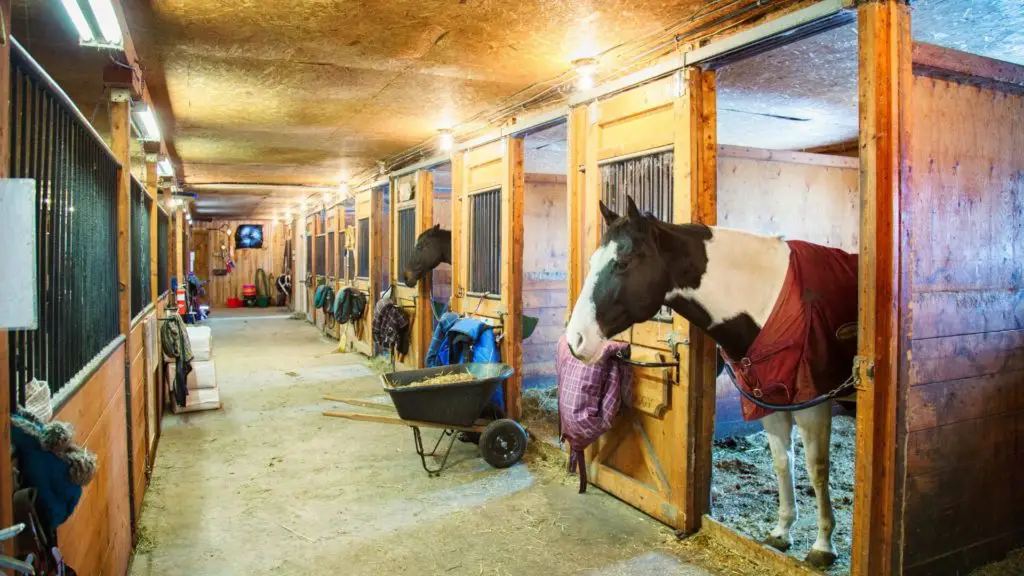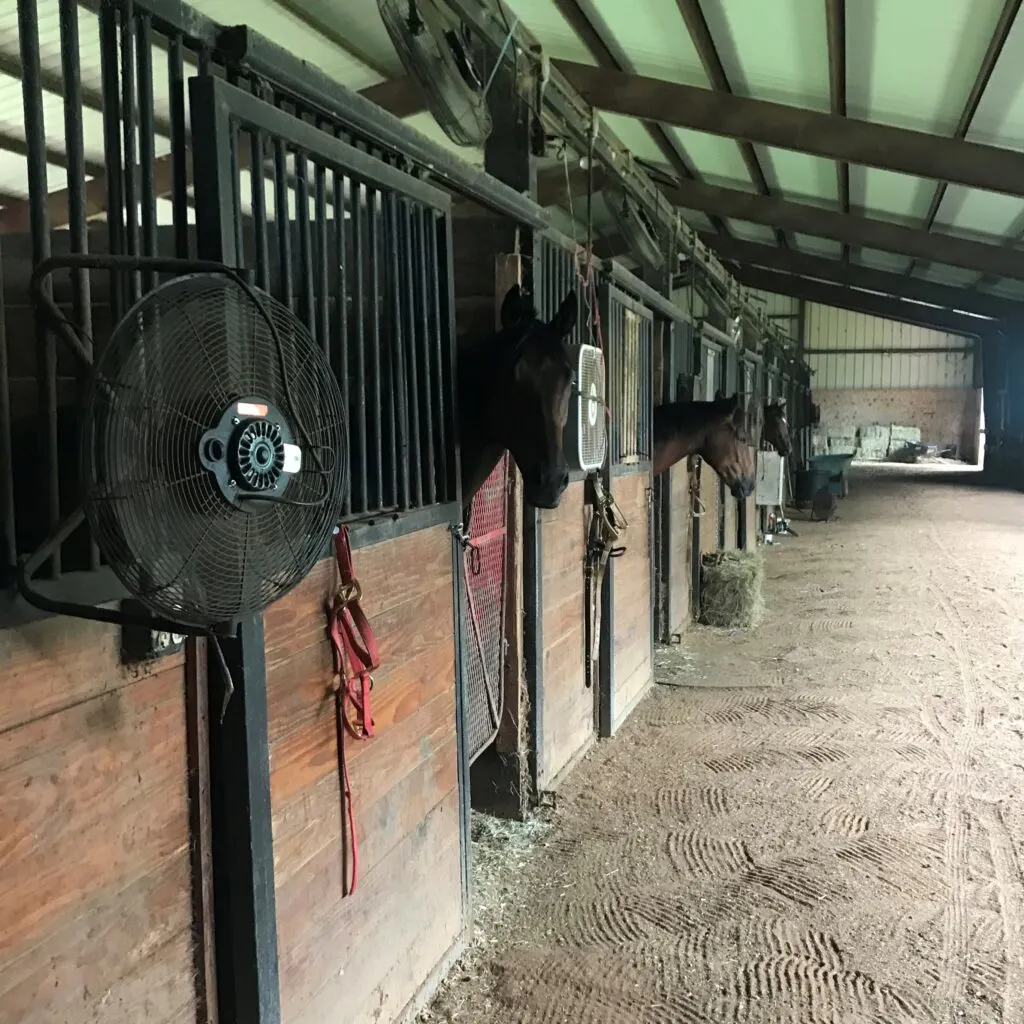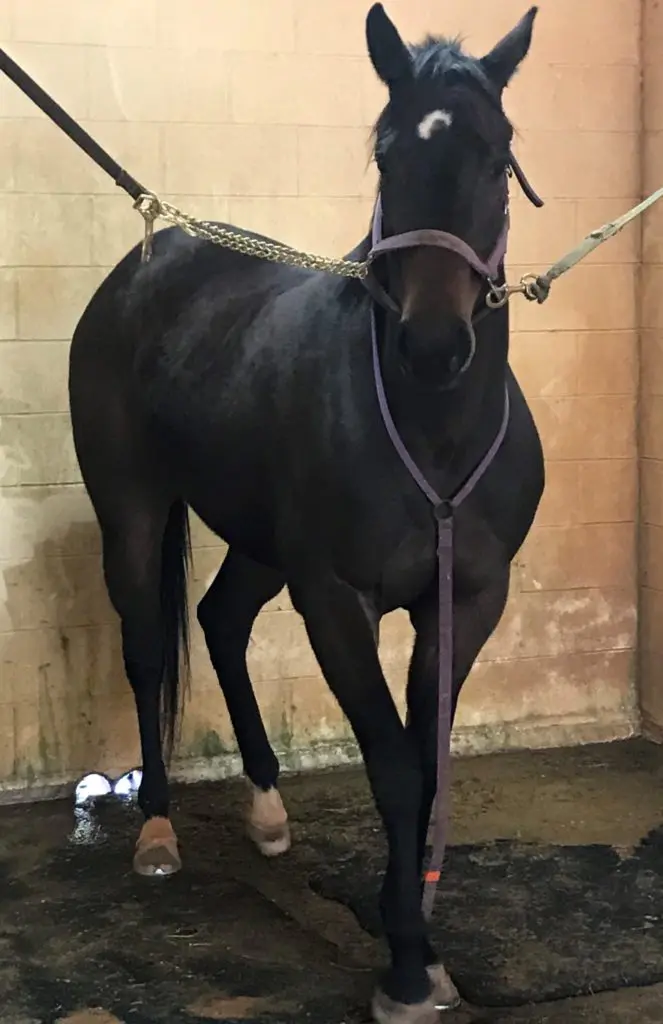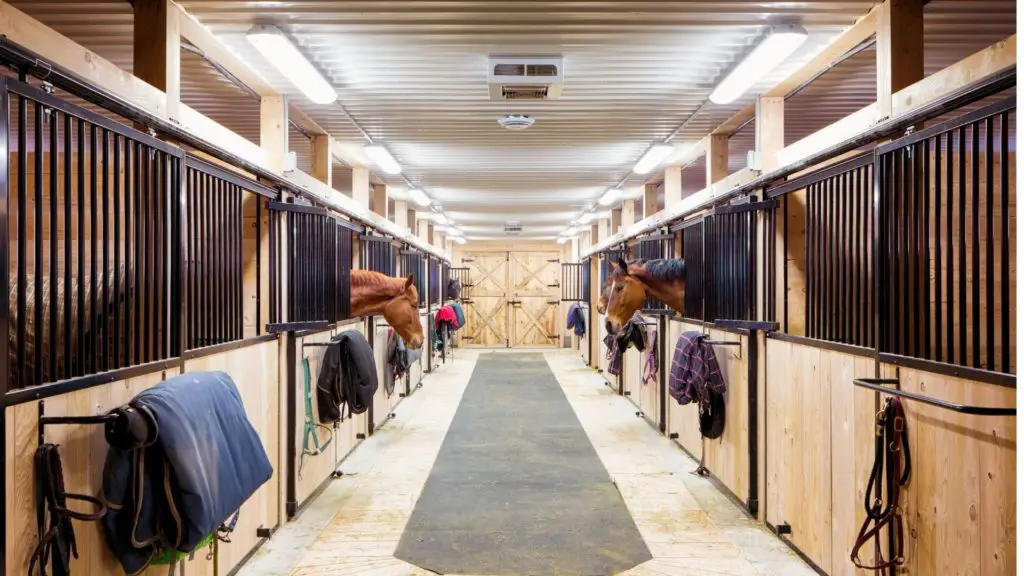Last updated: April 3, 2024
I’ve used several materials and researched many others to find the best barn flooring options for stalls, aisles, and tack rooms. If you plan to build a new horse barn or update an older one, the flooring surface you choose is crucial, so read on for our picks and advice.
| Material | Aisles | Stalls | Tack Room |
|---|---|---|---|
| Asphalt | Best | Good | Good |
| Clay | Fair | Best | Poor |
| Concrete | Fair | Fair | Best |
| Rubber mats | Good | Good | Good |
| Crushed stone | Good | Fair | Good |
Many people choose barn flooring based on price. However, there is much more to consider when picking the material for your horse barn floors. This article examines common barn flooring material, explains my choices, and offers some advice.
Choosing the right flooring for your horse barn.
Horse owners face many challenges in finding the right flooring material for their barns. Not the least of which are opinions. Between your friends, experts, and the internet, I’m sure you’ve gotten a bunch of conflicting information.

Old-timers have their tried-and-true favorites, and internet sites are pushing for modern composite materials that enhance your barn’s aesthetics and meet all your horses’ needs. These materials typically cost a fortune, but are they worth trying?
So how do you decide? There is no easy answer, but there are essential features to look for when choosing your barn flooring.
You and your horses’ safety and health are the primary considerations when choosing the material to use for your barn floor. An ideal surface is durable, has traction, and is easy to clean.
Horses are heavy, so you need a floor that can withstand the pressure of their immense weight without breaking. A slick surface is dangerous, especially for horses wearing shoes.
They could fall and injure themselves and their handler if they lose their footing. It’s essential to have flooring material that cleans easily to keep disease and pests at bay.

Here is a list of factors to consider when choosing the material to use for your barn flooring:
1) how will the floor impact the health of your horse;
2) how well does the floor dry;
3) is the surface slippery;
4) how much maintenance is required to keep it level;
5) how easy is it to clean; and
6) how expensive is it to install?
With these considerations, let’s look at common barn flooring material.
Asphalt
Asphalt is a black tar material made from crushed rock, sand, gravel, or slag combined with binders. It is used to build highways and parking lots.
Because it’s a composite of materials, there are various types; the most commonly used in barns is popcorn asphalt. It was initially developed to provide better water runoff than traditional asphalt.
Popcorn asphalt contains a higher percentage of aggregate, resulting in tiny surface gaps that allow moisture to wick away. Barn flooring built with popcorn asphalt typically has gravel or crushed stone base.
The combination of asphalt over stone works well to keep the surface dry. Horses with wet feet are prone to develop unhealthy hoofs and can develop thrush.
Asphalt is easy to clean; you can quickly shovel manure without making a hole and spray it down with water. Even though it has some give, I wouldn’t use it in a stall without a rubber mat covering and deep bedding.
Asphalt can be shaped and slightly crowned, making it ideal for aisles. It also provides traction, which will help prevent injuries, and it’s softer than concrete.
Popcorn asphalt is a good material for all areas of a barn, and it’s my top pick for aisleways.

Clay
Clay is fine soil that expands and shrinks depending on water content. Because it can withstand pressure, it’s typically used as a foundation for homes.
Because clay soils are natural, they are unique and come in many grades. Its clay is exposed to the environment; it will crack and break. However, for horse barns built correctly, clay is an excellent stall base.
A horse barn should have an exterior chain wall or be built high so water can’t enter stalls, and the clay needs to be firmly packed, ideally over a bed of crushed stone.
As you can see in the picture, we use clay for aisleways. If you decide to use clay, it’s critical to design the barn to protect the clay from rain. Too much water on the clay would make the walkway sloppy mess.
Yes, clay isn’t perfect, but no surface is; you and your horse will eventually create holes, either from mucking out the stalls or the animal lying in the same spot.
But the advantages outweigh the negatives. Clay is safe and cheap; it is a pliable and natural surface. Horses have a difficult time on stiff floors; standing and lying are both problems.
I wouldn’t use clay for tack rooms; it’s too dusty and hard to sweep. Clay can be a suitable choice in aisleways, but my problem has been walking wet horses over clay, which becomes slippery; I prefer asphalt.
Concrete
Concrete is a composite material made with three necessary ingredients: water, aggregate (rock, sand, or gravel), and cement. Water combined with cement binds the aggregates. The wet concrete mix is poured and hardened in place.
Concrete provides a stable, level base that lasts and is easy to clean. It’s impervious to rodents and difficult for horses to damage. Concrete is the favored barn floor material in Europe.

However, not all is rosy for concrete. Horses kept in stalls lay down to rest, and the concrete is hard, cold, and slick. Because it is so uncomfortable, horses avoid lying down on concrete floors.
And when they lie down, they often get sores on their hocks and have difficulty getting back to their feet because their hoofs slip on the hard surface.
In cold environments, concrete provides little comfort to a horse, and it has no flexion. Horses need a surface with “give” because they stand most of the time, and a floor with no give causes soreness in their hind legs.
These issues can be overcome by adding rubber mats, deep bedding material, and frequent turnouts. Horses in concrete stalls should have at least four hours a day outside.
A downside to rubber mats placed over concrete is that urine often gets trapped between the layers, creating unsanitary conditions. Concrete is also costly and permanent.
I prefer to use concrete in tack rooms and wash racks. Some people have a problem with concrete in wash racks because it’s slippery; however, I’ve never had a problem with our horses.
Concrete is a good material for aisles; however, it doesn’t provide the traction that asphalt does and is more expensive. If you decide to use concrete for your aisle, you can increase the amount of gravel in it to create additional traction.
Crushed stone
If properly installed, stall floors constructed of gravel or crushed limestone dust can make excellent barn flooring. Gravel or crushed stone should be placed over a good foundation of sand or other material that allows drainage.
Some crushed stones, when packed, can be as hard as concrete. Start with a level, hard surface and provide approximately 4 to 5 inches of crushed stone.
Crushed stone is excellent for barn aisles, tack rooms, and wash racks. It is also suitable for stalls, but like concrete, it has its issues. Sometimes, it is too stiff to provide the flexion your horse needs and is rough for horses to lay on.
Rubber Mats

Rubber cleans easily, is flexible, and is easy to maintain or replace. The downside is rubber mats are expensive; some are as much as $11.00 a square foot, price is based on thickness.
For best results, the foundation should be level and solidly packed when installing rubber mats. The best mats to use are one-piece sections that are 5/8 inch thick.
If you must use pieces, keep them to a minimum and fit them tightly together. Many rubber mats aren’t durable enough to withstand pawing. We used industrial rubber mats designed for heavy traffic and still had issues.
So, it’s best to purchase a mat specifically designed for use in livestock barns. Rubber mats provide good traction and can be laid over any level surface. However, heavy bedding must still be used over rubber mats to absorb urine.
FAQs
Is it bad for horses to stand on concrete?
Concrete is tough on horses, but it’s also durable. If you want your horse to be as comfortable in its stall as possible, try using mats or a generous layer of bedding- these can soften up the flooring and make life easier for your equine friend!
You can check out this article to learn more about using concrete stall floors: Can Horse Stalls Have Concrete Floors? Why Or Why Not
How often do horse stalls need to be cleaned?
In general, you should clean a horses’ stall every day. For horses that spend the majority of their time in a stall, it’s essential you keep their environment as sanitary as possible. A dirty stall can cause your horse to develop breathing problems, skin conditions, and hoof disease. Remember this is where they eat, sleep, and breathe.
Summary
Clay, concrete, and asphalt prices vary by region, so comparing barn flooring costs is challenging. However, we can generalize that rubber and concrete are the most expensive options.
Clay is the least expensive option but is high-maintenance. Popcorn asphalt is a good option because it is inexpensive, provides traction, and is easy to clean.
Concrete is stiff and will cause problems for horses when used in a stall, but it’s an excellent choice for tack rooms and wash racks. Gravel is suitable for all areas of a barn.
It drains well, provides traction, and when installed properly, it’s easy to clean. For use in horse stalls, it can be too hard and uncomfortable.
Below is a helpful YouTube video about choosing stall mats.
Related articles:
- 7 Best Horse Barn Fans For Stalls and Aisles
- Does a Horse Need a Barn? Shelter in a Pasture?
- What’s the Best Stall Bedding for Your Horse Barn? 4 Options
- Do Horse Fly Masks and Fly Boots Work? What Ones Are Best?
- Alfalfa Pellets vs. Cubes: What’s Better for Your Horses?
- What Does a Horse Eat? An Essential Feeding Guide
- Why some horses wear blankets
- The Very Best Grazing Muzzles, and Why Your Horse Needs One
